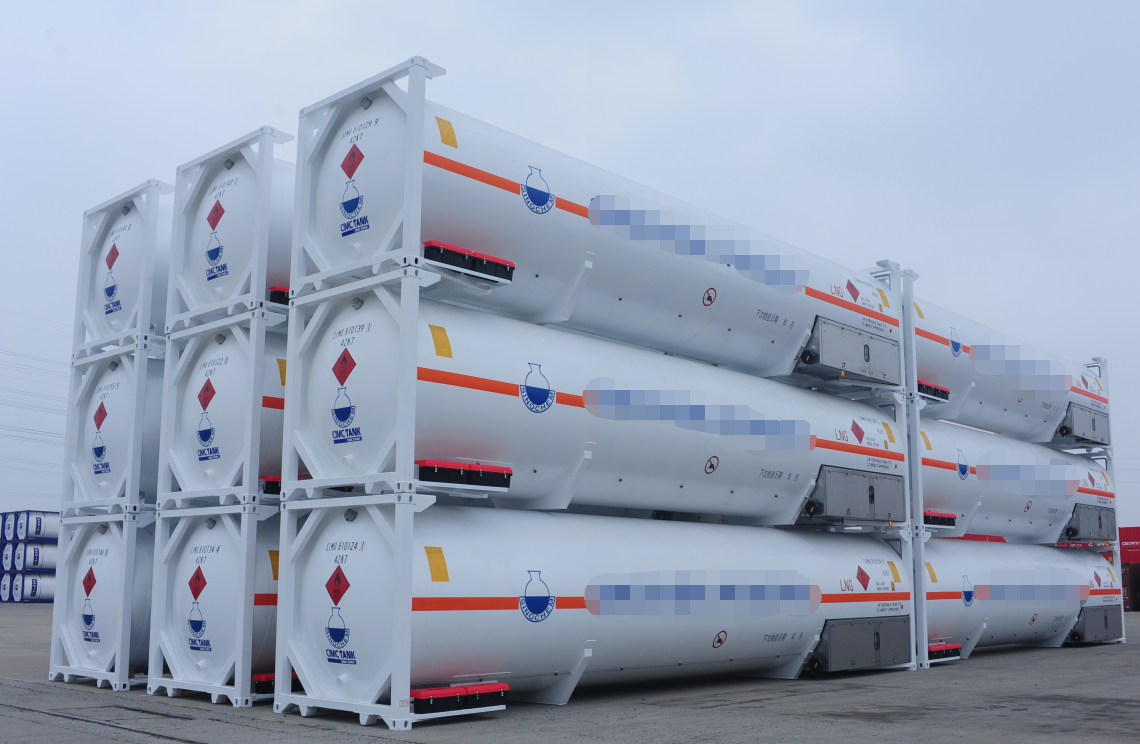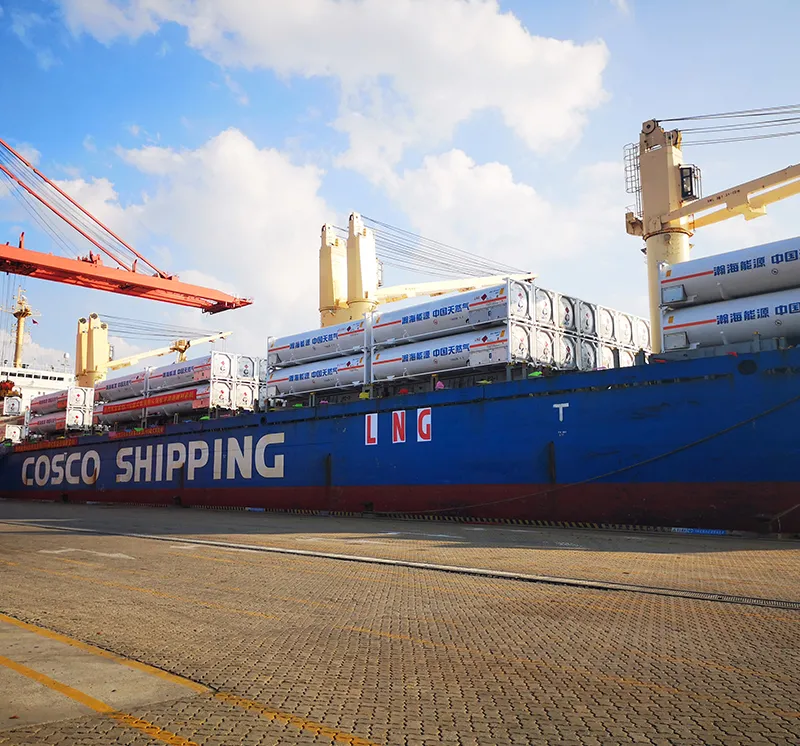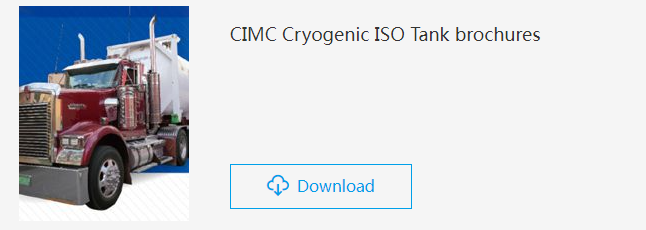Know LNG iso container the features, types and dimensions from LNG iso storage tanks manufacturer-CIMC ENRIC is engaged in the design, development, manufacturing, engineering and sales, as well as provision of technical maintenance services for, a wide range of transportation, storage and processing equipment used in the energy, chemical and liquid food industries. Cimc Enric is an industry leader in the design, engineering and manufacture of LNG transportation and storage tanks. We proudly serve our customers worldwide. Our rigorous testing ensures that all our LNG storage tanks meet all ISO standards and DOT regulations. We also understand that companies have different needs. We work directly with each customer to provide a custom lng transport solution based on pressure and containment requirements. The goal in providing LNG tanks is to achieve maximum payload safely and at a reasonable price.

LNG ISO Tank
What is an LNG iso container?
As the demand for international trade grows, so does the need for quality and reliable transport. To transport LNG on a global scale, LNG iso containers meet this need with a variety of customizable features.
In many countries, LNG iso tank containers are used to optimize the energy supply chain and to obtain liquefied natural gas (LNG) for use in cities and remote areas. LNG iso tank containers offer an effective solution to the problem of LNG supply.
Generally, LNG ISO tank containers are manufactured according to ISO standards (International Organisation for Standardisation) and are used for the transport of various liquids and gases. More specifically, LNG iso containers are designed for the efficient water transport of liquefied natural gas (LNG).
These iso tanks are made of stainless steel. In addition, they have multi-layer vacuum-insulated pressure tanks, supported by double-walled transport tanks. Thus allowing them to hold LNG at temperatures of -162 °C (-260 °F). The LNG ISO tank containers have a maximum pressure level of 0.690 MPa.
The LNG iso tank container has two containers - an inner tank with LNG and an outer tank with insulating material. Fully sealed tanks are the most common and their size varies depending on their purpose. Transporting LNG in ISO tanks is an innovative and effective alternative to traditional natural gas distribution.

LNG ISO Containers
LNG iso tank container market overview
Here is a quick summary of what is happening in the LNG iso tank market.
The global LNG iso tank container market is estimated to be US$159.1 million by 2021 and is expected to reach US$264 million by 2028.
In 2021, Europe is the largest region in the LNG iso tank container market, with North America in second place.
To find out more about the latest LNG iso tank market trends, please contact us.
Key Features of LNG ISO Tanks:
● Robust Construction: LNG ISO tanks are constructed using high-quality materials to withstand the extreme conditions associated with LNG transportation. They are designed to handle the low-temperature environment and maintain the LNG in its liquid state.
● Insulation and Thermal Protection: The tanks incorporate advanced insulation materials and techniques to minimize heat transfer, ensuring that the LNG remains at its required temperature during transportation. This helps to prevent the LNG from vaporizing and ensures safe and efficient delivery.
● Safety Features: LNG ISO tanks are equipped with multiple safety features to ensure the secure transportation of LNG. These may include emergency shut-off valves, pressure relief devices, and integrated monitoring systems to detect and address any potential leaks or abnormalities.
● Standardized Design: The tanks follow international standards, ensuring compatibility with various transportation modes and facilities worldwide. They are built to ISO dimensions and can be easily loaded onto container ships, railcars, or truck trailers, providing seamless intermodal transportation.
● Capacity Options: LNG ISO tanks come in various capacity options, ranging from small to large volumes, to meet different customer requirements. This allows for flexibility in choosing the appropriate tank size based on the specific transportation needs.
● Regulatory Compliance: LNG ISO tanks comply with industry standards and regulations, ensuring safety, environmental protection, and legal compliance. They are designed and manufactured to meet the stringent requirements set by international bodies and local authorities.
● Maintenance and Service: Regular maintenance and inspection are crucial for the safe operation of LNG ISO tanks. Manufacturers often provide support services, including maintenance guidelines, spare parts availability, and technical assistance, to ensure the long-term performance and reliability of the tanks.
Types of liquids that ISO tank containers can transport
1. Molasses
2. Milk and other dairy products
3. Alcoholic and non-alcoholic beverages
4. Liquefied sugars
5. Hydrogen peroxide
6.Sulfuric/nitric acid
7. Chemicals/solvents
8. Liquid foodstuffs
9. Heating oil/vegetable oil
10. Gasoline/diesel / liquefied petroleum gas
11. Liquid Resin
Benefits of LNG ISO Tanks:
● Flexibility: LNG ISO tanks provide flexibility in transporting LNG to various locations, allowing for intermodal transportation via road, rail, or sea.
● Cost-Effectiveness: The use of LNG ISO tanks reduces the need for specialized LNG terminals and infrastructure, resulting in lower transportation costs compared to other delivery methods.
● Safety and Security: LNG ISO tanks are designed with comprehensive safety features, ensuring the secure transportation of LNG and minimizing the risk of accidents or leaks.
● Reduced Emissions: The transportation of LNG in ISO tanks promotes the use of cleaner energy, as LNG has lower carbon emissions compared to other fossil fuels, contributing to environmental sustainability.
The LNG iso container and its specifications
So far, we know that the LNG iso tank container is the most efficient container for transporting liquefied natural gas. There are 2 types of LNG iso tank containers commonly used in the shipping industry. These are the standard 20ft and 40ft LNG ISO containers. To best serve their purpose, each type and size has its own unique specifications.
Let's take a closer look at each of their specifications and indicators.
● 20ft LNG iso tank container
LNG can be transported over longer distances using cryogenic ISO tank containers. This allows for a more cost effective supply of fuel to end users far from the LNG supply source. A 20ft cryogenic LNG ISO container provides a storage capacity of 22,000 liters at a working pressure of 17 BAR.
Container size (L x W x H/mm): 6,058 x 2,438 x 2,591
Design code: ASME/GB
Load Weight: 26000~28500KG
Design temperature: -196~+50℃
● 40ft LNG iso tank container
Container size (L x W x H/mm): 12,192 x 2,438 x 2,591
Design code: ASME/GB
Load Weight: 30480~34000KG
Design temperature: -196~+50℃
● 45ft standard cryogenic LNG iso tank container
The newly developed 45ft water-land intermodal tank containers have independent intellectual property rights and excellent vacuum performance. Both 45ft position and 40ft transport angle can be suitable for many kinds of skeleton trucks at home an abroad. Meanwhile, additional 45ft lifting equipment at the wharf is not necessary either, back-installed pipeline is easier to the transportation and operation of end users.

Safety precautions for lng iso tank containers
As LNG is a highly flammable material, special care must be taken when handling LNG iso tank containers - there is a risk of leakage if they are not stored properly and if they do leak, the safety of the transport driver can hardly be guaranteed. Here are some key safety tips to consider when transporting LNG.
The initial filling is usually carried out on a cryogenic tank that has been reactivated after the contents of an ambient cryogenic tank contain a period of stored cryogenic liquid.
Before the initial filling, the liquid level meter and pressure gauge should be checked and calibrated, check whether the various valves are in the correct state of opening and closing, whether the pipeline is open to open the pressure gauge valve, according to the liquid level meter operating procedures to make the liquid level meter in operating condition
When the cryogenic storage tank is used for high purity cryogenic liquid, it should be blown out of the replacement process. The method is: using 70℃~80℃ dry oil-free air or nitrogen, heating blowing out the contents, blowing out time should be not less than 8 hours, then use the product gas for a replacement about lighter than air nitrogen, should be imported from the venting valve, from the bottom liquid import and export valve discharge, about heavier than air oxygen or gas, should be imported from the bottom liquid import and export valve, from the venting valve discharge, when the cryogenic storage tank pressure reaches 0.1 -0.2MPa, discharge the replaced gas, so repeated several times, and the purity of the discharged gas testing, satisfactory before stopping the replacement of each valve pipeline also apply the product gas blowing, and satisfied with the purity requirements after the replacement of positive pressure sealing 4, filling storage of general cryogenic liquid, without the above blowing replacement process
The first filling, advocates the use of atmospheric pressure filling, that is, before filling open the contents of the emptying valve, to be closed only after all the filling is completed, filling process in the contents of the vessel at atmospheric pressure or low pressure, the operation is convenient about filling rare or valuable cryogenic liquids, can first cryogenic storage tank cylinder with liquid nitrogen cooling, with low-temperature product gas replacement to the specified purity, and then filled with cryogenic liquids.
When handling natural gas, the gas may seep into clothing, so avoid smoking near the tank, especially when filling and discharging. In the event of a leak, remove all sources of ignition and disconnect the gas supply. In addition, shut off leaks and electrical installations and maintain adequate ventilation. Avoid sealing containers containing liquefied gases. If kept sealed, evaporation of the gas may cause a pressure rise. This increase in pressure can lead to personal injury and damage to equipment.
The cost of a tank container can vary depending on the tank type and specifications, location, availability, and sometimes manufacturer.
CIMC ENRIC was established in 2004 and became one of the leading specialized gas equipment manufacturers and an integrated business solutions service provider in the gas energy industry in China.
You have found LNG iso tank containers just what you are looking for. But now, how do you find them? Sourcing Iso tank containers, let alone LNG ISO tanks, can be a tedious and stressful process due to the scarcity on the market. But fortunately, we have the LNG iso tank container solution for you.
CIMC ENRIC has competitive price and quick delivery,our lng iso containers have one year warranty after delivery.
Click to get the best service plan